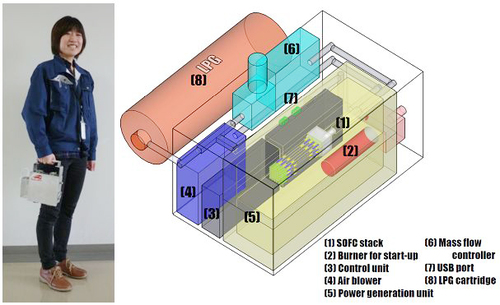November 15, 2013
AIST Develops Portable Fuel Cell System to Run on Compact Butane Gas Cartridge
Keywords:
Copyright National Institute of Advanced Industrial Science and Technology All Rights Reserved.
The National Institute of Advanced Industrial Science and Technology of Japan (AIST) announced on January 28, 2013, that it had developed a handy fuel cell system employing microtubular solid oxide fuel cells (SOFC). By controlling the nanostructure of the electrode to have an internal reforming function, the system can be used directly with portable general-purpose hydrocarbon fuels, including liquefied petroleum gas (LPG).
SOFCs have the highest power generation efficiency among fuel cells. In principle, hydrogen and hydrocarbons, including methane and butane, can be used to generate power by producing an electrochemical reaction with oxygen in the air. However, butane, one of the main constituents of LPG, is likely to trigger carbon deposition as a result of thermal decomposition, deteriorating electrodes when supplied directly to fuel cells, stopping power generation within a few hours. This problem meant that conventional fuel cell systems had to reform butane fuel by using an external reformer equipped with expensive noble metal catalysts before the butane can be supplied to the fuel cells.
The newly developed system stably generates power, even when the butane is directly supplied to the system, as it uses electrodes with an internal reforming function attained by adding nanometer-size ceria (CeO2). The system only uses the LPG burner for start-up, not requiring any external power supply.
AIST aims to apply this SOFC power generation system as a power source during disaster and emergency situations, for outdoor use and for next-generation vehicles.



